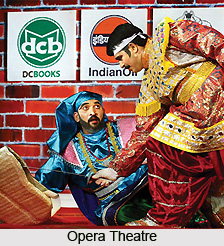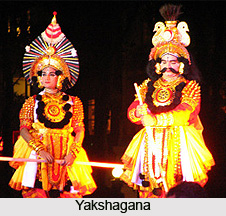 Opera theatre in Karnataka, a musical representation of drama, is a more advanced and refined medium than the Spoken-word play in the West. It is capable of portraying different emotions of different characters at the same time. The opera in the West is inevitably associated with the "emotional dance", though not to the same extent as the ballet. The contribution of the orchestra to Western opera is considerable. The atmosphere built up by the opera, in spite of the feeling that its intense romantic music is not invariably in good taste has earned for it an eminent position. The opera in our country is not so closely associated with the dance. It is just a poetical tale or a fiction presented in music and acting, aided by a few musical instruments.
Opera theatre in Karnataka, a musical representation of drama, is a more advanced and refined medium than the Spoken-word play in the West. It is capable of portraying different emotions of different characters at the same time. The opera in the West is inevitably associated with the "emotional dance", though not to the same extent as the ballet. The contribution of the orchestra to Western opera is considerable. The atmosphere built up by the opera, in spite of the feeling that its intense romantic music is not invariably in good taste has earned for it an eminent position. The opera in our country is not so closely associated with the dance. It is just a poetical tale or a fiction presented in music and acting, aided by a few musical instruments.
Kannada Operas, though small in number, have exhibited a high musical quality and have proved to be quite dramatic. B. M. Srikantiah`s Aswathaman, a play modelled on Greek Tragedy with a number of excellent choruses and songs, truly attained the status of an opera. Masti Venkatesha Iyengar`s Timpani, with its rich treasure of songs and intense drama was another striking work. Neither of these, however, received from the Amateur stage the serious attention they deserved.
It was Shivarama Karanth who wrote operas, composed music for them, acted in them and established them as a dynamic art-form on the Amateur stage. His operas are based on apparently common place themes: but he endowed these themes with beauty and power, for he is a writer of remarkable skill and clarity of vision. Only some of them like Ritu Yatre (The Cycle of seasons) and Buddhodaya (Birth of the Buddha) include dances, but every one of them is an intense emotional experience for the spectator. Lava-Kusha and Satyavan Savitri deal with well-known mythological themes while Kisa Gotami and Buddhodaya are based on Buddhist legends. Ritu Yatre portrays rural life set against the background of Nature. Muktadwara pictures the story of humanity and of the prophets who failed to uplift it. Both the operas can become magnificent in production, rich as they are in the opportunities they provide for dance and music. Sotniya Saubhagya is again an opera in which the dance has a great role to play. It is a poignant tragedy set in rural atmosphere. Yaro Andaru, which deals with the strange manifestations of the village scandal, is a triumph for Karanth, the satirist.
All the operas of Karanth including even the long Badukabahudu have been staged. Some of them like; Kisa Gotami, Lava-Kusa and Savitri Satyavaana have remained highly popular. Lava-Kusa has been staged with equal success as a Dumb-show and as a Shadow Kannada theatre also.
 It was Karanth`s operas which showed for the first time in Karnataka that music and gesture can create great drama. He has written music for them mostly in appropriate ragas of Hindustani Classical music. Many a folk musical pattern has given them great charm. Some of his operas, like Somiya Saubhagya, Lava-Kusa and Savitri Satyavan have been aided by the chorus which, with its narrative music carries the story forward, reacts to the emotions of the characters and adds strength and beauty to the performance. It may look at first sight as though the properties at the disposal of the amateur stage are too limited for the grand imagery provided by Ritu Yatra, where Nature, cruel, kindly and unpredictable, is made an important character. But even this work could be produced with effect provided Nature is represented symbolically.
It was Karanth`s operas which showed for the first time in Karnataka that music and gesture can create great drama. He has written music for them mostly in appropriate ragas of Hindustani Classical music. Many a folk musical pattern has given them great charm. Some of his operas, like Somiya Saubhagya, Lava-Kusa and Savitri Satyavan have been aided by the chorus which, with its narrative music carries the story forward, reacts to the emotions of the characters and adds strength and beauty to the performance. It may look at first sight as though the properties at the disposal of the amateur stage are too limited for the grand imagery provided by Ritu Yatra, where Nature, cruel, kindly and unpredictable, is made an important character. But even this work could be produced with effect provided Nature is represented symbolically.
Whether operas by Karnath need proper settings or not, they, do demand musical and histrionic talent and careful productions. When Karanth himself produces his operas, they rarely fail to provide a new and unforgettable experience to the discerning. P. T. Narsimhachar, a noted poet with a real sense of music and drama, recreated great stories from the epics in his full length operas like Ahalya and Gohula Nirgamana. His operas are charged with deep emotion and high sentiment and are essentially poetic in atmosphere. But their production seems to be beyond the reach of the Amateur theatre stage of Karnataka. If they could ever be done in full, they would provide a rare and elevating experience. Hitherto, however, in spite of attempts to bring them on the stage in parts, the operas of P. T. N. have yet remained Shravya Kavya, in that they are widely read and frequently broadcast. Kumar Venkanna wrote three operas dealing with national themes - Bharata Shakti, Bharata Geeta and Odeda Kanasu.
The first, deals with the significance of Independence of India, and the third is a satire on party politics in India. In their movement and structure, his operas seem to have been influenced by Yakshagana. There is scope for music, dance and shadow-effects in them. Keerthinath Kurtakoti, a young poet of Gadag composed attractive operas like Swapnadarshi and Sabari. Like Pavana Pavaka of Mugali, Swapnadarshi sketches on a vast canvas, the adventures of a sensitive youth in quest of the Light of Knowledge. The opera became a stirring experience to the listener when it was produced by Pandit Bhimsen Joshi on the air. Though simple in theme, Keerti`s operas prove impressive owing to their emotional intensity and subtle poetry, if Karanth`s operas are essentially dramatic and those of Narasimhachar are intrinsically poetical, Keerti`s have a gobd measure of both the qualities. His operas have been staged by student-amateurs of Gadag. Of the recent contributors to Kannada opera, mention may be made of Ammembala Shankaranarayana and K. V. Subbanna.




















